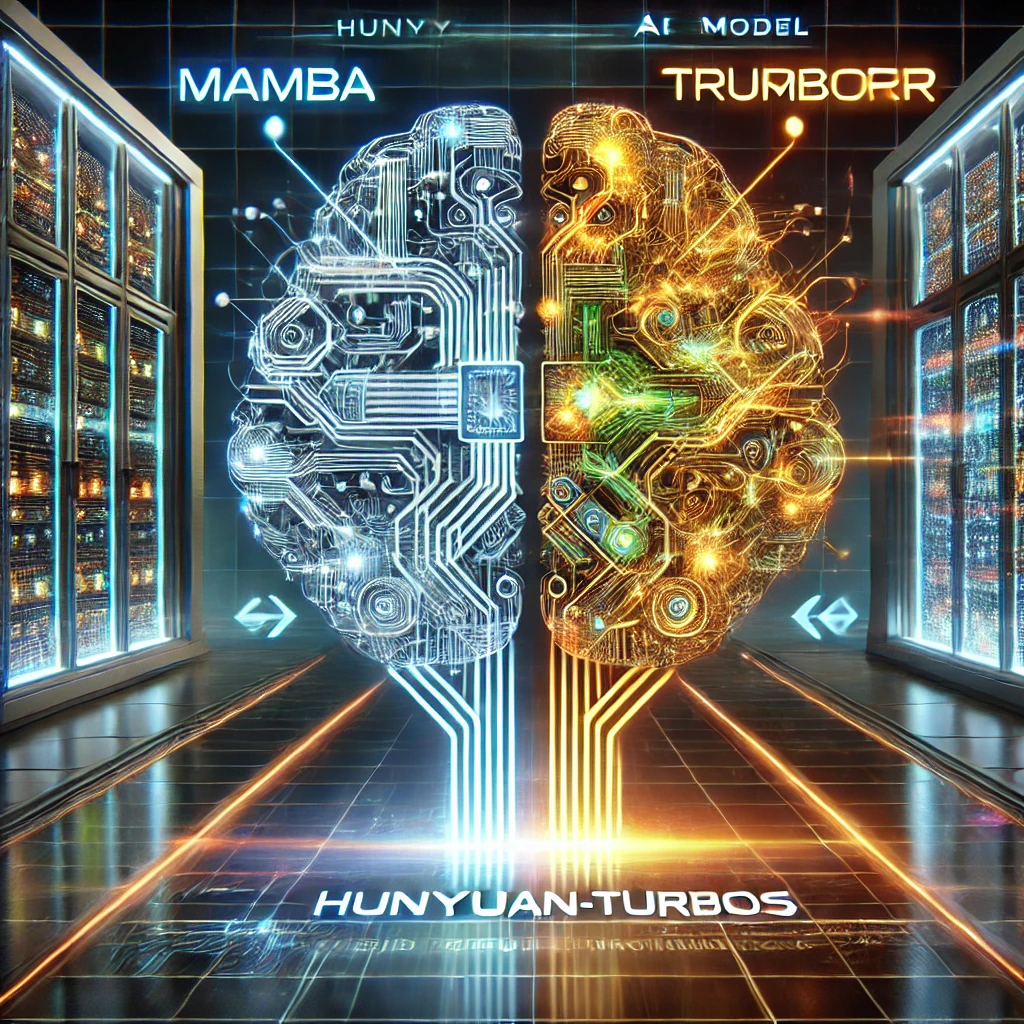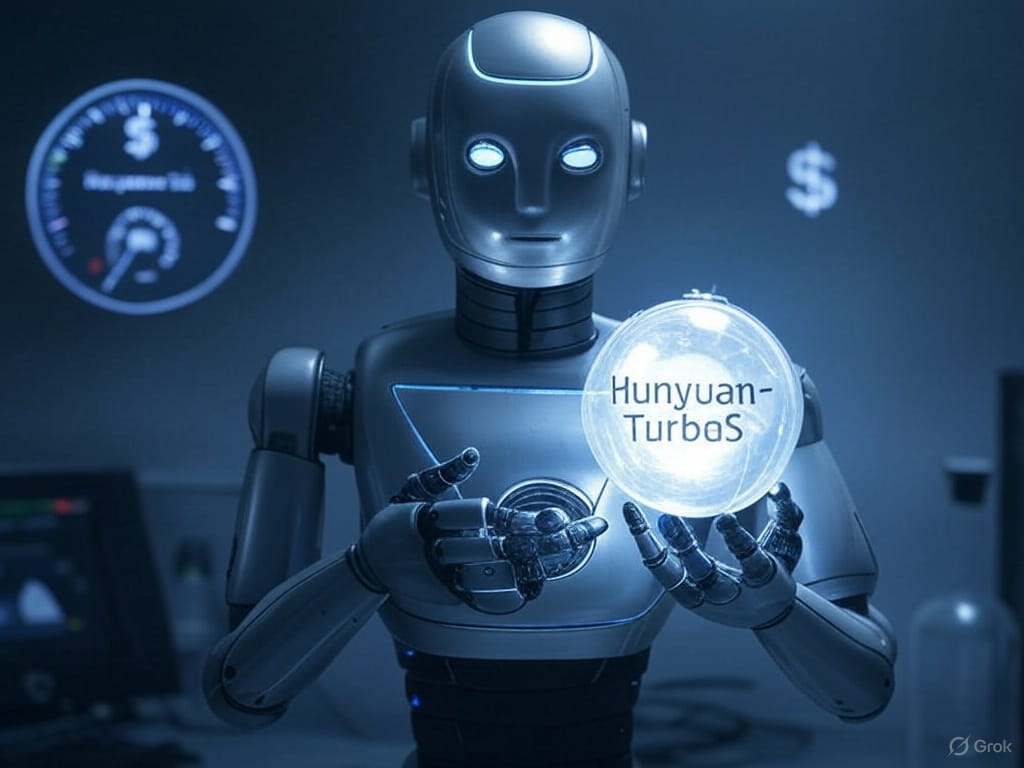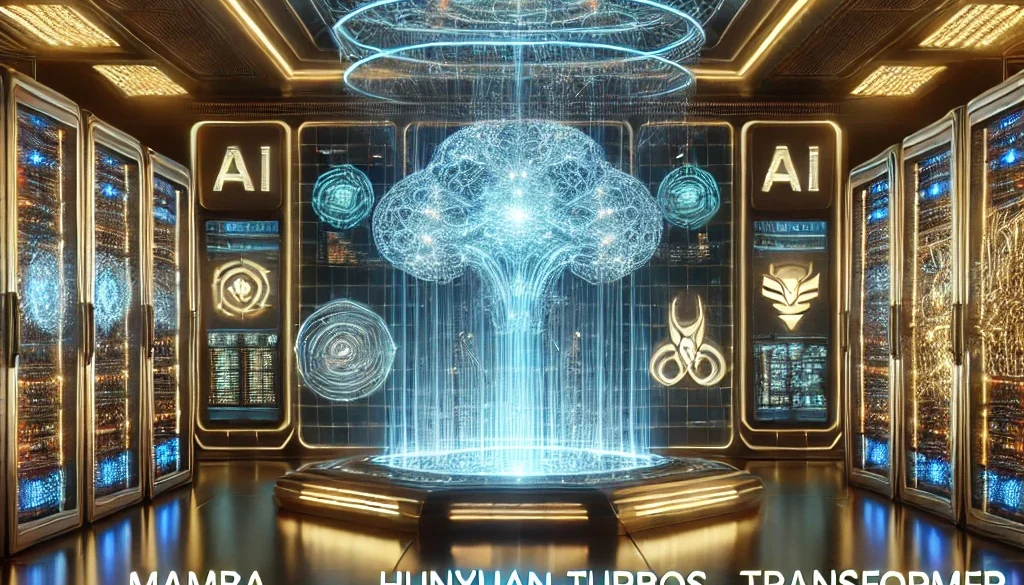Tencent’s New Transformer-Mamba AI Model: A Game-Changer for Efficiency?
Introduction
The 21st century is all about AI and technology. In the rapidly evolving landscape of artificial intelligence, Tencent has unveiled a groundbreaking innovation: the Hunyuan-TurboS AI model. This revolutionary technology combines the strengths of two powerful architectures—Mamba and Transformer—into a hybrid system that promises to redefine efficiency and performance in AI applications.
So in this article, we will be diving deep and share some insights upon this topic and discuss questions like what it is? And much more..
Table of Contents

What Are Transformer Models?
Before moving these topics might be complex for some so lets break them down…
Simple:-
Think of a Transformer model like a really smart librarian who helps you figure things out fast. You walk up and say something, like “I like sunny days.” This librarian doesn’t just hear you—he listens to every word and thinks about how they fit together. He’s got a huge stack of books in his head, full of stuff he’s learned, like “Sunny Days Are Warm” or “People Smile on Sunny Days.” Instead of reading one book at a time, he flips through all of them at once, picks out the best bits, and says, “You like sunny days because they’re bright and fun!” It’s super quick, like he’s got magic speed-reading powers. That’s what Transformer models do in computers—they help it understand and talk back to us, like for chat apps or writing helpers, without making it complicated.
ALSO LEARN ABOUT AI AGENTS
Technical:-
Transformer models are a type of neural network architecture introduced in 2017 by Ashish Vaswani and his team at Google Brain. They revolutionized the field of natural language processing (NLP) and have since been applied to various machine learning tasks, including computer vision and audio processing
Key Features of Transformer Models
- Sequence-to-Sequence Architecture: Transformers are designed to handle sequential data, such as text or time-series data, using an encoder-decoder structure
- Attention Mechanism: This allows the model to focus on specific parts of the input sequence when generating output, enabling efficient processing of long-range dependencies
- Parallelization: Unlike traditional recurrent neural networks (RNNs), transformers can process input sequences in parallel, reducing training time
Limitations of Traditional Transformer Models
Despite their success, traditional transformer models face several challenges:
- High Computational Requirements: Training transformer models requires significant computational resources and energy, contributing to a high carbon footprint
- Long Training Times: The complexity of these models means they take a long time to train, which can hinder rapid experimentation and development
- Complex Architecture: This complexity also limits model interpretability, making it difficult to understand why certain predictions are made
- Static Parameters: Once trained, transformer models have static parameters and cannot learn continuously from new data
- Data Sensitivity: Transformers are sensitive to the quality and quantity of training data, which can be challenging in data-scarce environments
- Scalability Issues: As sequence lengths increase, the computational cost scales quadratically, making it difficult to handle very long sequences efficiently
These limitations highlight the need for innovations like hybrid models, such as Tencent’s Hunyuan-TurboS, which aim to address some of these challenges by combining different architectures to improve efficiency and performance.
DO CHECK LATEST NEWS ON MANUS AI
What is Hunyuan-TurboS?
Hunyuan-TurboS is the first ultra-large Hybrid-Transformer-Mamba MoE (Mixture of Experts) model, designed to overcome the limitations of traditional Transformer models. These models often struggle with processing long sequences due to their O(N²) complexity and KV-Cache issues, leading to high operational costs and performance bottlenecks.
Transformer: So again, think of this as a brainy librarian. It’s great at understanding big, complicated things—like long books or tricky questions—but it can be slow and needs a lot of computer power.
- Mamba: Picture a speedy assistant who zips through long lists without getting tired. It’s fast and light but not always as deep a thinker.
By mixing these, Tencent created an AI that’s both clever and quick. The “Mixture of Experts” part means it’s like a team: different pieces work together to tackle specific tasks, making it extra efficient.
ALSO READ: FOXCON’S AI PUSH
Key Features of Hunyuan-TurboS
- Hybrid Architecture: By merging the Mamba and Transformer architectures, Hunyuan-TurboS achieves a balance between speed and deep reasoning. Mamba excels at processing long sequences efficiently, while Transformers provide exceptional contextual understanding.
- Fast and Slow Thinking: The model incorporates mechanisms for both fast and slow thinking, mimicking human cognitive processes. Fast thinking enables rapid responses to simple queries, while slow thinking handles complex tasks like mathematical problems or logical reasoning
- Cost-Effectiveness: Hunyuan-TurboS significantly reduces operational costs, with its inference cost being only one-seventh that of its predecessor. This makes it an attractive option for large-scale AI deployments.
Potential Applications of Hunyuan-TurboS
- Natural Language Processing (NLP): Faster and more accurate text generation, translation, and chatbot performance.
- Healthcare: Improved diagnostic models, predictive analytics, and AI-assisted research.
- Autonomous Systems: Smarter AI models for self-driving cars, robotics, and automated decision-making.
- Financial Services: Advanced fraud detection, algorithmic trading, and risk assessment tools.
- Gaming and Entertainment: AI-driven game development, interactive storytelling, and dynamic user experiences.
Why Is It a Big Deal for Efficiency?

Efficiency in AI isn’t just tech jargon—it’s about getting more done with less. Here’s why Hunyuan-TurboS stands out:
1. Lightning-Fast Answers
This model can reply to questions in under a second. Compare that to older AIs that take a few seconds to “think.” Whether it’s solving math or chatting, speed matters—especially for apps or businesses needing instant results.
2. Cheaper to Run
Big AIs like ChatGPT need tons of computer power, which costs money and energy. Hunyuan-TurboS uses less, like a car that gets great gas mileage. For companies, this could mean lower bills and a smaller carbon footprint.
ALSO READ : OPENAI BILLION DOLLAR BET ON COREWEAVE
ChatGPT vs Hunyuan-TurboS AI
Here’s a comparison between ChatGPT and Hunyuan-TurboS AI models based on available information:
Overview
- ChatGPT: Developed by OpenAI, ChatGPT is a popular AI chatbot known for its conversational capabilities and ability to generate human-like text. It has been widely used for tasks ranging from answering questions to creating content.
- Hunyuan-TurboS: Launched by Tencent, Hunyuan-TurboS is a hybrid AI model that combines Mamba and Transformer architectures. It is designed for fast responses and reduced operational costs, making it competitive in the AI market.
Key Features
| Feature | ChatGPT | Hunyuan-TurboS |
|---|---|---|
| Architecture | Transformer-based | Hybrid Mamba-Transformer |
| Speed | Known for conversational speed, but can be slower than Hunyuan-TurboS in some scenarios | Claims to respond in less than a second, outperforming DeepSeek R1 and similar models |
| Cost-Effectiveness | Generally considered high-cost due to computational requirements | Significantly cheaper to use, with costs many times lower than previous models |
| Performance | Highly capable in generating human-like text and answering questions | Comparable performance to DeepSeek-V3 in areas like knowledge, math, and reasoning |
| Integration | Widely integrated into various platforms via OpenAI API | Available on Tencent Cloud and integrated into platforms like WeChat |
Comparison Points
- Speed and Efficiency: Hunyuan-TurboS is designed to provide faster responses, making it more suitable for applications requiring instant answers. ChatGPT, while fast, may not match the speed of Hunyuan-TurboS in all scenarios.
- Cost: Hunyuan-TurboS offers a more cost-effective solution, which is crucial for large-scale deployments. ChatGPT, being part of the OpenAI ecosystem, typically involves higher costs due to its computational requirements.
- Performance and Versatility: Both models are highly capable in their respective domains. ChatGPT excels in generating human-like text and conversational interactions, while Hunyuan-TurboS matches DeepSeek-V3 in specific tasks like math and reasoning.
- Integration and Accessibility: ChatGPT is widely available through the OpenAI API, making it accessible to a broad range of developers. Hunyuan-TurboS is integrated into Tencent’s ecosystem, including WeChat, which provides significant market reach in China.
DeepSeek vs Hunyuan-TurboS AI
Here’s a comparison between DeepSeek AI and Hunyuan-TurboS AI models based on available information:
Overview
- DeepSeek AI: Developed by a Chinese startup, DeepSeek AI is an open-source language model known for its competitive performance and cost-effectiveness. It uses a Mixture-of-Experts (MoE) architecture and has shown strong results in mathematical reasoning and coding tasks
- Hunyuan-TurboS: Launched by Tencent, Hunyuan-TurboS is a hybrid AI model combining Mamba and Transformer architectures. It is designed for fast responses and reduced operational costs, making it competitive in the AI market.
Key Features
| Feature | DeepSeek AI | Hunyuan-TurboS |
|---|---|---|
| Architecture | Mixture-of-Experts (MoE) | Hybrid Mamba-Transformer |
| Speed | Fast response times, especially for longer queries | Claims to respond in less than a second |
| Cost-Effectiveness | Significantly cheaper than competitors, with low training costs | Offers reduced operational costs compared to traditional models |
| Performance | Strong in mathematical reasoning and coding tasks | Comparable performance to DeepSeek-V3 in certain tasks |
| Integration | Open-source, available on platforms like Hugging Face | Integrated into Tencent’s ecosystem, including WeChat |
Comparison Points
- Architecture and Efficiency: DeepSeek AI uses a MoE architecture, which allows for efficient processing by activating only relevant model parts. Hunyuan-TurboS combines Mamba and Transformer architectures for both speed and contextual understanding.
- Performance: DeepSeek AI excels in mathematical reasoning and coding tasks, while Hunyuan-TurboS is noted for its overall performance comparable to DeepSeek-V3.
- Cost and Accessibility: DeepSeek AI is open-source and offers a cost-effective pricing structure, making it accessible to a wide range of users. Hunyuan-TurboS also reduces operational costs but is more integrated within Tencent’s ecosystem.
- Integration and Accessibility: DeepSeek AI is available on platforms like Hugging Face, providing flexibility for developers. Hunyuan-TurboS is integrated into Tencent’s services, which may limit its accessibility compared to open-source models.
Grok(xAI) vs Hunyuan-TurboS AI
Here’s a comparison between Grok 3 (xAI) and Hunyuan-TurboS AI models based on available information:
Overview
- Grok 3 (xAI): Developed by Elon Musk’s xAI, Grok 3 is a powerful AI model known for its advanced reasoning capabilities and synthetic data training. It is positioned as a revolutionary model that outperforms its predecessors and competitors in various tasks.
- Hunyuan-TurboS: Launched by Tencent, Hunyuan-TurboS is a hybrid AI model combining Mamba and Transformer architectures. It is designed for fast responses and reduced operational costs, making it competitive in the AI market.
Key Features
| Feature | Grok 3 (xAI) | Hunyuan-TurboS |
|---|---|---|
| Architecture | Advanced reasoning capabilities, synthetic data training | Hybrid Mamba-Transformer |
| Speed | Enhanced computational power, but specific speed metrics not detailed | Responds in under a second, with doubled speech rate and reduced latency by 44% |
| Cost-Effectiveness | No specific cost-effectiveness metrics provided, but likely high due to advanced hardware | Offers reduced operational costs compared to traditional models |
| Performance | Outperforms leading models in internal tests, including math and science tasks | Comparable performance to DeepSeek V3 in knowledge, math, and reasoning |
| Integration | Available on X platform and through Grok web/app versions | Integrated into Tencent’s ecosystem, including WeChat |
Comparison Points
- Speed and Efficiency: Hunyuan-TurboS is designed to provide extremely fast responses, often in under a second, making it suitable for real-time applications. Grok 3’s speed is enhanced by advanced hardware, but specific metrics are not detailed.
- Architecture and Training: Grok 3 uses synthetic data training and advanced reasoning capabilities, while Hunyuan-TurboS combines Mamba and Transformer architectures for efficiency and contextual understanding.
- Cost and Accessibility: While Grok 3 is available through premium subscriptions on the X platform, Hunyuan-TurboS is integrated into Tencent’s services and offers a more cost-effective solution
- Integration and Ecosystem: Grok 3 is part of xAI’s ecosystem, with plans for further integration into voice assistance and other applications. Hunyuan-TurboS is deeply integrated into Tencent’s platforms, including WeChat.
Overview
- Grok 3 (xAI): Developed by Elon Musk’s xAI, Grok 3 is a powerful AI model that boasts significant advancements in computational power and reasoning capabilities. It is positioned as a revolutionary model that outperforms its predecessors and competitors in various tasks
- Hunyuan-TurboS: Launched by Tencent, Hunyuan-TurboS is a hybrid AI model combining Mamba and Transformer architectures. It is designed for fast responses and reduced operational costs, making it competitive in the AI market.
FOR STUDENTS : FREE 15+ AI TOOLS

What Could This Mean for You?
This isn’t just tech nerd stuff—it could hit your life soon. Here’s how:
- Faster Apps: Imagine chatbots or virtual assistants that don’t make you wait. Ordering food or getting help could feel instant.
- Cheaper Tech: If companies save money on AI, they might pass savings to you—think lower subscription fees for AI tools.
- More AI Everywhere: Efficiency means more businesses can afford AI, from small startups to big chains like McDonald’s (who, by the way, just started using AI today too!).
Conclusion
Tencent’s Transformer-Mamba model isn’t just a new toy—it’s a sign of where AI’s heading. Faster, cheaper, and still smart, Hunyuan-TurboS could shake up how we build and use tech. Whether you’re a coder, a business owner, or just someone who loves a quick chatbot, this matters. Efficiency isn’t sexy, but it’s powerful—and Tencent might’ve just cracked the code.
What do you think—could this be the future of AI? Drop your thoughts in the comments, and follow me for more tech breakdowns!




